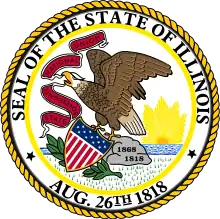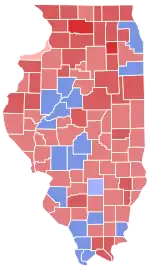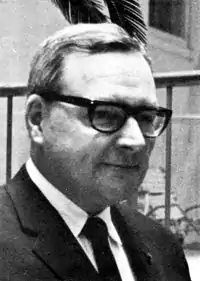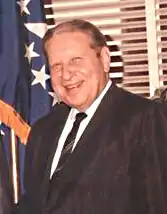1968 Illinois elections
Elections were held in Illinois on Tuesday, November 5, 1968.[1]
| ||
| Turnout | 82.91% | |
|---|---|---|
|
| ||
| Elections in Illinois |
|---|
 |
Primaries were held on June 11, 1968.[1]
Election information
Federal elections
United States President
Illinois voted for the Republican ticket of Richard Nixon and Spiro Agnew.[1]
United States Senate
Incumbent Senator Everett M. Dirksen, a Republican, won reelection to a fourth term.
United States House
All 24 Illinois seats in the United States House of Representatives were up for election in 1968.
No seats switched parties, leaving the Illinois House delegation to continue to consist of 12 Democrats and 12 Republicans.
State elections
Governor
| |||||||||||||||||
| Turnout | 79.39%[1] | ||||||||||||||||
|---|---|---|---|---|---|---|---|---|---|---|---|---|---|---|---|---|---|
| |||||||||||||||||
 County Results Ogilvie: 50-60% 60-70% 70-80% Shapiro: 40–50% 50–60% | |||||||||||||||||
| |||||||||||||||||
Incumbent Democratic Governor Samuel H. Shapiro, lost reelection to Republican Richard B. Ogilvie.
| Party | Candidate | Votes | % | |
|---|---|---|---|---|
| Republican | Richard B. Ogilvie | 2,307,295 | 51.21 | |
| Democratic | Samuel H. Shapiro (incumbent) | 2,179,501 | 48.37 | |
| Socialist Labor | Edward C. Gross | 19,175 | 0.43 | |
| Write-in | Others | 29 | 0.00 | |
| Total votes | 4,506,000 | |||
Lieutenant Governor
| |||||||||||||||||
| Turnout | 76.96%[1] | ||||||||||||||||
|---|---|---|---|---|---|---|---|---|---|---|---|---|---|---|---|---|---|
| |||||||||||||||||
| |||||||||||||||||
Democrat Paul Simon won election to serve as lieutenant governor.
This was the only time in Illinois history that the state had the elected a governor and a lieutenant governor from different political parties (there were, however, instances in Illinois where an appointed lieutenant governor had been of a different political party than the governor).
Due to changes implemented by the passage of the 1970 Constitution of Illinois, in all subsequent elections, gubernatorial and lieutenant gubernatorial candidates have been jointly elected on a ticket. Therefore, this was the last Illinois election held for the sole purpose of electing a lieutenant governor.
Democratic primary
| Party | Candidate | Votes | % | |
|---|---|---|---|---|
| Democratic | Paul Simon | 600,369 | 100 | |
| Write-in | Others | 6 | 0.00 | |
| Total votes | 600,375 | 100 | ||
Republican primary
| Party | Candidate | Votes | % | |
|---|---|---|---|---|
| Republican | Robert A. Dwyer | 534,882 | 100 | |
| Write-in | Others | 6 | 0.00 | |
| Total votes | 534,888 | 100 | ||
General election
| Party | Candidate | Votes | % | |
|---|---|---|---|---|
| Democratic | Paul Simon | 2,222,331 | 50.87 | |
| Republican | Robert A. Dwyer | 2,125,910 | 48.67 | |
| Socialist Labor | Stanley L. Prorok | 20,122 | 0.46 | |
| Write-in | Others | 2 | 0.00 | |
| Total votes | 4,368,365 | |||
Attorney General
| |||||||||||||||||
| Turnout | 79.79%[1] | ||||||||||||||||
|---|---|---|---|---|---|---|---|---|---|---|---|---|---|---|---|---|---|
| |||||||||||||||||
| |||||||||||||||||
Incumbent Attorney General William G. Clark, a Democrat, did not seek a third term. Republican William J. Scott was elected to succeed him.
Democratic primary
| Party | Candidate | Votes | % | |
|---|---|---|---|---|
| Democratic | Francis S. Lorenz | 611,138 | 100 | |
| Write-in | Others | 14 | 0.00 | |
| Total votes | 611,152 | 100 | ||
Republican primary
| Party | Candidate | Votes | % | |
|---|---|---|---|---|
| Republican | William J. Scott | 581,595 | 76.67 | |
| Write-in | Others | 1 | 0.00 | |
| Total votes | 581,595 | 100 | ||
General election
| Party | Candidate | Votes | % | |
|---|---|---|---|---|
| Republican | William J. Scott | 2,322,572 | 52.71 | |
| Democratic | Francis S. Lorenz | 2,065,984 | 46.89 | |
| Socialist Labor | George P. Milonas | 17,488 | 0.40 | |
| Write-in | Others | 2 | 0.00 | |
| Total votes | 4,528,836 | 100 | ||
Secretary of State
| |||||||||||||||||
| Turnout | 78.81%[1] | ||||||||||||||||
|---|---|---|---|---|---|---|---|---|---|---|---|---|---|---|---|---|---|
| |||||||||||||||||
| |||||||||||||||||
Incumbent Secretary of State Paul Powell, a Democrat, was reelected to a second term.
Democratic primary
| Party | Candidate | Votes | % | |
|---|---|---|---|---|
| Democratic | Paul Powell (incumbent) | 617,231 | 100 | |
| Write-in | Others | 47 | 0.01 | |
| Total votes | 617,278 | 100 | ||
Republican primary
| Party | Candidate | Votes | % | |
|---|---|---|---|---|
| Republican | Donald D. Carpentier | 502,497 | 76.67 | |
| Republican | Brian B. Duff | 153,017 | 23.34 | |
| Write-in | Others | 6 | 0.00 | |
| Total votes | 655,520 | 100 | ||
General election
| Party | Candidate | Votes | % | |
|---|---|---|---|---|
| Democratic | Paul T. Powell (incumbent) | 2,278,868 | 50.94 | |
| Republican | Donald D. Carpentier | 2,173,839 | 48.59 | |
| Socialist Labor | George LaForest | 20,664 | 0.46 | |
| Write-in | Others | 9 | 0.00 | |
| Total votes | 4,473,380 | 100 | ||
Auditor of Public Accounts
| |||||||||||||||||
| Turnout | 76.54%[1] | ||||||||||||||||
|---|---|---|---|---|---|---|---|---|---|---|---|---|---|---|---|---|---|
| |||||||||||||||||
| |||||||||||||||||
Incumbent Auditor of Public Accounts Michael Howlett, a Democrat, was reelected to a third term.
Democratic primary
| Party | Candidate | Votes | % | |
|---|---|---|---|---|
| Democratic | Michael J. Howlett (incumbent) | 591,297 | 100 | |
| Write-in | Others | 13 | 0.00 | |
| Total votes | 591,310 | 100 | ||
Republican primary
| Party | Candidate | Votes | % | |
|---|---|---|---|---|
| Republican | William C. Harris | 272,742 | 46.26 | |
| Republican | Terrel E. Clarke | 183,855 | 31.19 | |
| Republican | Wesley W. "Wes" Olson | 132,932 | 22.55 | |
| Write-in | Others | 1 | 0.00 | |
| Total votes | 589,530 | 100 | ||
General election
| Party | Candidate | Votes | % | |
|---|---|---|---|---|
| Democratic | Michael J. Howlett (incumbent) | 2,215,401 | 50.99 | |
| Republican | William C. Harris | 2,106,676 | 48.49 | |
| Socialist Labor | Elizabeth Schnur | 22,591 | 0.52 | |
| Write-in | Others | 1 | 0.00 | |
| Total votes | 4,344,669 | 100 | ||
Clerk of the Supreme Court
| |||||||||||||||||
| Turnout | 76.46%[1] | ||||||||||||||||
|---|---|---|---|---|---|---|---|---|---|---|---|---|---|---|---|---|---|
| |||||||||||||||||
| |||||||||||||||||
The Clerk of the Supreme Court was Cleli Woods, who took office after the death in office of Lula Searcy earlier in 1968. Before her death, Searcy had been unseated in the Republican primary by Justin Taft, who went on to win the general election.
The 1970 Constitution of Illinois made it so that the office would become an appointive office by 1975, thus rendering the 1968 election the last instance in which an election was held for this office.
Democratic primary
| Party | Candidate | Votes | % | |
|---|---|---|---|---|
| Democratic | Fannie G. Jones | 565,289 | 100 | |
| Write-in | Others | 5 | 0.00 | |
| Total votes | 565,294 | 100 | ||
Republican primary
Instead of being listed by her own name, Lula Searcy opted to be listed on the ballot as "Ms. Earle Benjamin Searcy".[1][2]
| Party | Candidate | Votes | % | |
|---|---|---|---|---|
| Republican | Justin Taft | 264,959 | 45.01 | |
| Republican | Lula Searcy (incumbent) | 188,635 | 32.04 | |
| Republican | Louise Emerson | 135,103 | 22.95 | |
| Write-in | Others | 5 | 0.00 | |
| Total votes | 588,702 | 100 | ||
General election
| Party | Candidate | Votes | % | |
|---|---|---|---|---|
| Republican | Justin Taft | 2,286,086 | 52.68 | |
| Democratic | Fannie G. Jones | 2,032,768 | 46.84 | |
| Socialist Labor | Gregory P. Lyngas | 21,117 | 0.49 | |
| Write-in | Others | 1 | 0.00 | |
| Total votes | 4,339,972 | 100 | ||
State Senate
Seats of the Illinois Senate were up for election in 1968. Republicans retained control of the chamber.
State House of Representatives
Seats in the Illinois House of Representatives were up for election in 1968. Republicans retained control of the chamber.
Trustees of University of Illinois
| ||
|
| ||
An election using cumulative voting was held for three of nine seats for Trustees of University of Illinois system.
The election saw the reelection of incumbent incumbent third-term Republican Timothy W. Swain and incumbent second-term Republican member Earl M. Hughes and the election of new Republican member Russell W. "Ruck" Steger.[1][4]
Incumbent Democrat Kenney E. Williamson (appointed in 1967 after the death in office of Wayne A. Johnston) lost reelection.[1][4]
| Party | Candidate | Votes | % | |
|---|---|---|---|---|
| Republican | Timothy W. Swain (incumbent) | 2,246,505 | 17.49 | |
| Republican | Earl M. Hughes (incumbent) | 2,222,696 | 17.30 | |
| Republican | Russell W. Steger | 2,176,223 | 16.94 | |
| Democratic | Kenney E. Williamson (incumbent) | 2,063,859 | 16.06 | |
| Democratic | Timothy R. Ives | 2,043,974 | 15.91 | |
| Democratic | Frances Best Watkins | 2,003,652 | 15.60 | |
| Socialist Labor | Edwin L. Williams | 33,031 | 0.26 | |
| Socialist Labor | Henry Schilling | 31,399 | 0.24 | |
| Socialist Labor | Clarys L. Essex | 26,768 | 0.21 | |
| Write-in | Others | 2 | 0.00 | |
| Total votes | 12,848,109 | 100 | ||
Judicial elections
Judicial elections were held, including two elections to fill vacancies on the Illinois Appellate Court.[1]
Ballot measures
Three ballot measures were up for election in 1968, a legislatively referred state statute, a bond measure, and a call for a constitutional convention.[1]
In order to be approved, legislatively referred state statues required the support of a majority of those voting on the statute.[1] Bond measures needed a vote equal to majority of the votes cast for whichever chamber of the Illinois General Assembly had the highest cumulative vote count.[1] A call for a constitutional convention required votes equal to a majority of the all ballots cast in the general election.[1]
Illinois Banking Act
Illinois Banking Act was approved by voters as a legislatively referred state statue.[1] It enabled Illinois state banks to have foreign branches.[5]
| Candidate | Votes | % | |
|---|---|---|---|
| Yes | 1,776,492 | 61.95 | |
| No | 1,091,116 | 38.05 | |
| Total votes | 2,867,608 | 100 | |
| Voter turnout | 50.52% | ||
Illinois Natural Resources Development Bond Act
Illinois Natural Resources Development Bond Act, a legislatively referred bond question, failed to pass.[1][6] It proposed a $1 billion bond act for the development of natural resources.[6]
Bond measures needed a vote equal to majority of the votes cast for whichever chamber of the Illinois General Assembly had the highest cumulative vote count.[1] In this election, the highest turnout for a chamber's elections was 4,268,956, so the needed vote total for the measure to have pass would have been 2,134,479.[1]
| Illinois Natural Resources Development Bond Act[1][6] | |||
|---|---|---|---|
| Option | Votes | % of highest legislative vote cast | |
| Yes | 1,656,600 | 38.81 | |
| No | 1,216,814 | 28.50 | |
| Total votes | 2,873,414 | 67.31 | |
| Voter turnout | 50.62% | ||
Proposed call for a Constitutional Convention
In 1968, voters were presented with a referendum on whether or not to call a constitutional convention.[7][8] This was the first such vote held in the State of Illinois since 1934.[8] The chief sponsor of the legislation which created this ballot measure was Senate Republican leader W. Russell Arrington.[9] Democratic Governor Otto Kerner Jr. was supportive of holding a constitutional convention.[9]
The call for the constitutional required the votes of an equal majority of all ballots cast in the 1968 general elections.[1]
A constitutional convention was subsequently held, and the resulting Constitution of Illinois approved by Illinois voters in a 1970 special election.[8]
| Proposed call for a Constitutional Convention[1][10] | |||
|---|---|---|---|
| Option | Votes | % of all ballots cast | |
| Yes | 2,979,972 | 63.33 | |
| No | 1,135,440 | 24.13 | |
| Total votes | 4,115,412 | 87.45 | |
| Voter turnout | 72.50% | ||
Local elections
Local elections were held.
References
- "OFFICIAL VOTE Cast at the GENERAL ELECTION NOVEMBER 5, 1968 JUDICIAL PRIMARY ELECTION GENERAL PRIMARY, JUNE, 11, 1972" (PDF). Illinois State Board of Elections. Retrieved 26 June 2020.
- Illinois Blue Book 1967-1968. Illinois Secretary of State. p. 884. Retrieved 28 March 2020.
- "OFFICIAL VOTE Cast at the GENERAL ELECTION NOVEMBER 4, 1986" (PDF). www.elections.il.gov. Illinois State Board of Elections. Retrieved 10 April 2020.
- "Trustees, University of Illinois Board of Trustees" (PDF). University of Illinois. Retrieved 1 April 2020.
- "Illinois Banking Act, Amendment 1 (1968)". Ballotpedia. Retrieved 29 March 2020.
- "Illinois Natural Resources Development Bond Act, Amendment 2 (1968)". Ballotpedia. Retrieved 29 March 2020.
- CALLING AND HOLDING ILLINOIS' SIXTH CONSTITUTIONAL CONVENTION (PDF). Illinois Legislative Council. 23 February 1972. p. 2. Retrieved 28 March 2020.
- Klemens, Michael D. (June 1987). "The state of the State Preparing for the next call for a constitutional convention". Illinois Issues. Retrieved 28 March 2020.
- "87. Senate Joint Resolution 2 Calling for a Constitutional Convention (1967)". www.cyberdriveillinois.com. Office of Illinois Secretary of State. Retrieved 29 March 2020.
- "Illinois Constitutional Convention Question (1968)". Ballotpedia. Retrieved 29 March 2020.


_(1).jpg.webp)

.jpg.webp)